We are in a time when diving technologies and practices are growing at an unprecedented rate. Unfortunately in these times, diving compasses are seen less and less as an essential component of a scuba equipment set. When new divers begin to compile their own sets they typically purchase fins, a mask, snorkel, computer, BCD, and perhaps even a wetsuit.
This checklist usually does not include a compass, though.
This is reasonable should their compass be integrated to their dive computer, as many new models feature.
However if not, picking the best dive compass is and should remain an important part of the dive equipment set. They provide us with an extra safety net, navigation in the case a diver gets lost or disoriented. We can use compasses for unique, calculated, exploration of unknown areas and dive sites. Compasses can be used to map dive sites to make the lives more convenient of those who choose to dive without one. We even use them for precision angles when implementing search patterns during a search and recovery.
Lastly, they allow us to perpetuate the knowledge of important navigation skills to coming generations of divers.
So what do you need to consider when hunting for a new dive compass?
Best Scuba Diving Compasses Reviewed
There’s a few aspects to think about. But luckily, dive compasses are not typically seen as highly priced as their fellow diving equipment. This leaves some wiggle room to test different models and find the one that really suits you best.
One of the major things to account for when looking at dive compasses is the various mount options: wrist watch style, console, clip on, hose, and even more. Where is the most convenient place for you to access your compass?
I would typically recommend a mount similar to your computer for easy reference. Another thing to consider is the degree marker increments. Most are in increments of ten, however it is possible to find smaller increments for more precision. Many smaller increment models are actually digital compasses integrated into dive computers. I would also take into account whether the compass has side view capabilities. Prices of compasses vary, so a potential buyer might want to consider what features are important to them and what their needs for a compass are to determine at what price point they should shop.
The following is my list of the best dive compasses to help you find what style and type of compass suits your needs best:
Cressi Dive Compass
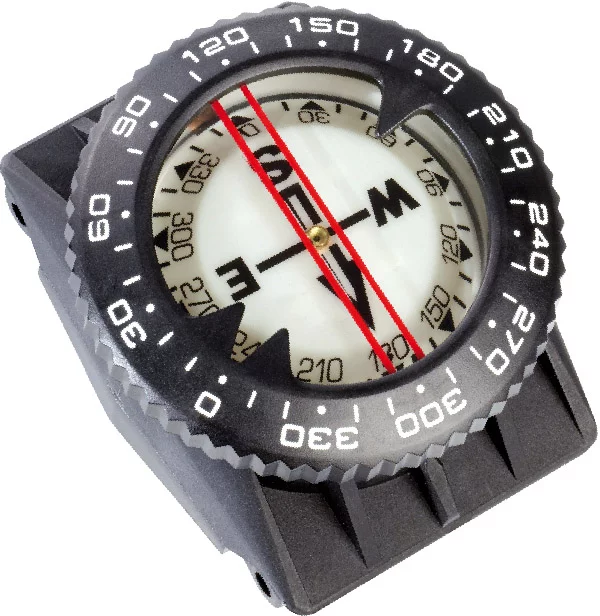
I like simple and efficient. That’s why my top pick for the best diving compass is the Cressi Dive Compass. The Cressi compass is versatile in its ability to attach by hose for easy access near your SPG or can be fashioned into a wrist mount. Either way, it is simplistic and offers the usual features of a diving compass. You need not worry about brand compatibility either for hose mounting. It’s in ten degree increments, offers a side view, and a ratcheted bezel. For a diver new to underwater navigation, Cressi could not have made a compass easier to learn and use effectively. The compass also comes with a bargain price tag.
The biggest draw of this device from Cressi for me is the easy and effective operation at a low price. As a dive professional, I use dive compasses constantly. This model is brilliant because my students never have any trouble learning how to use it. The large numbers and ratcheted bezel make for easy communication underwater when teaching navigation or exploring with my fellow divers. With that said, in my experience using dive compasses, divers share them and pass them around a lot–especially in teaching scenarios. This means I lose a lot of compasses and never see them again. This would be devastating with a dive computer, but with the Cressi Dive Compass coming in at around just $40.
Key Features:
- Wrist or Hose Mount
- Ten Degree Increments
- Ratcheted Bezel
- Simplistic, Durable Design
Pros:
- Cheap price tag
- Easy to read numbers underwater
- Simple to use
- Great for teaching navigation
Cons:
- It’s a bit bulky and may take up unnecessary space
- Known to be slightly less responsive than other compasses
Suunto SK8 Dive Compass
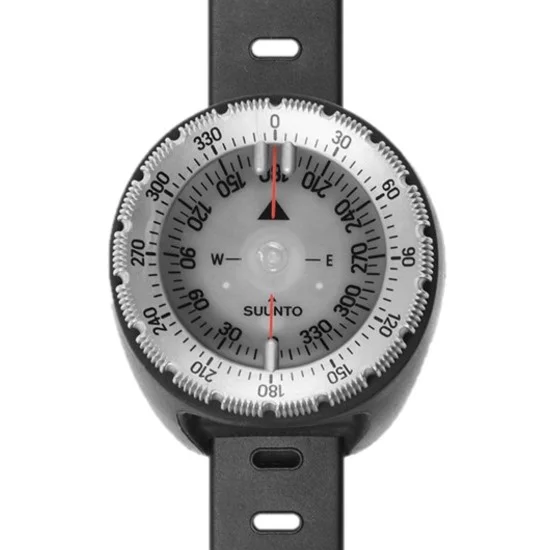
Suunto regularly tops my lists when it comes to dive technologies, and for good reason. Suunto has one consistency when they release diving gear: they create user-friendly, quality equipment. Nothing has changed when it comes to their navigation offering, the Suunto SK8. This compass is here for the long game and is durable enough it might easily be the most resilient piece of equipment in your entire set. This super-compass can be mounted on your wrist, be used as a console, or be used as retractable. This makes the SK8 one of the most versatile models out there. Similar to the Cressi Compass, the SK8 offers a ratcheted bezel, large, easy-to-read writing, and fairly simplistic usability. Rather than increments of ten, it features increments of five and very precise readings.
Once again, price plays a big part in my opinion of this compass. It reaches so high on my list because it might just be the best quality compass money can buy right now which carries a lot of merit. However, it carries a hefty price tag of nearly $85. This is a work horse of a compass and certainly deserving of such a high cost. Personally, I’m not confident this is a price point I would be willing to spend for a diving compass. Don’t let my personal opinion deter you though, this is easily the most popular dive compass on the market. With the amount and quality of features this device offers, you will likely be spending in this price range anyways.
Key Features:
- Ratcheted Bezel
- Wrist, Console, Retractable Mount Options
- Five Degree Increments
- Sub Zero Temperatures Compatible
- Incredibly Durable
Pros:
- Will last a long time
- Very accurate and precise readings
- Easy and simplistic to use
- Mount versatility
Cons:
- High price for dive compass
- Compass has been known to get stuck occasionally
Suunto Core
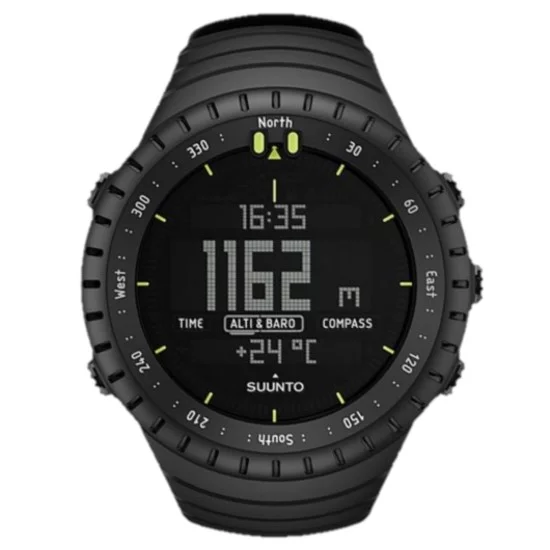
As I said, Suunto consistently puts out high quality equipment. Therefore, it comes as no surprise they made my list for a second time. This next compass was not actually designed for diving at all. This is a killer gadget meant for any and all outdoor adventures and luckily with a depth profile of up to 30 meters/100 feet, this includes diving. While the conservative depth limitations and design not specifically for diving may be great enough drawbacks to deter some divers from checking out this gadget, Suunto has created a navigation console not to be missed. This compact wrist mount watch features an altimeter, barometer, and compass. In addition it can also read the temperature, features a storm alarm, tells sunrise and sunset times, has a depth meter, and date and time.
My thoughts on this computer are a bit ambiguous. On one hand, I am wowed by the incredible navigation and survival features the Core offers, however I would be hesitant to use this as a consistent diving compass. With a depth rating to 30 meters/100 feet, I think the customer is offered some solace should they choose to use this model for underwater navigation, but it is not specifically designed for aquatic use. With a price tag of nearly $350, it is quite the financial risk to use this bad boy for consistent diving. I would certainly recommend this watch for snorkeling or freediving, though. Both of these activities would be easier on the device and likely lessen the chances of any leakage.
Key Features:
- Compass
- Altimeter
- Barometer
- Depth Meter
- Depth Rating 30 meters/100 feet
- Date & Time
- Thermometer
Pros:
- Countless features
- Gather more in-depth information for dive profiles
- Great for freediving and snorkeling
- Versatility, use for adventures beyond diving
- Offers many features a dive computer provides
Cons:
- Not designed specifically for diving
- Depth limitations
- Possibly prone to leakage if used consistently for diving
- Cannot be used in substitution for a dive computer
Oceanic Wrist Mount Compass
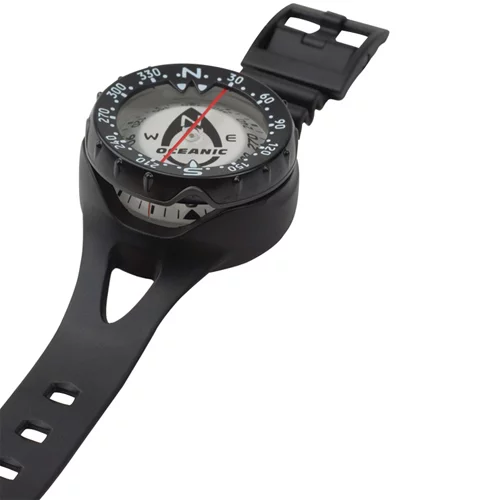
Similar to my first choice on this list, the Cressi Compass, the Oceanic Wrist Mount Compass offers a simplistic, durable, modestly priced choice for divers seeking a user-friendly dive compass. This compass has very responsive, accurate readings and offers top or side view navigation. It’s pretty difficult to justify not purchasing this compass. It will last an amazingly long time and consistently offer the diver precision accuracy. As many of the other choices on this list, the Oceanic Wrist Mount also features a ratcheted bezel and clear, easy to read writing.
I think this device’s ultimate calling card that helps it stand out from the rest of the compasses on the market is Oceanic’s patented Ocean Glo technology. The luminescent floating card inside the compass absorbs light and glows. As a result, this compass is fantastic in low visibility situations, night diving, cave diving, and more. This gadget also comes in with a bit of a hefty price tag for a compass at around $85. Unless your needs are specific to low visibility requirements, making the Ocean Glo a mandatory feature for you, I ranked the Oceanic Wrist Mount lower than the Suunto SK8 because if I am going to spend in this price range for a dive compass, the SK8 offers more features and higher quality. The Oceanic Wrist Mount is still a very durable, long lasting, and simplistic diving compass.
Key Features:
- Ten Degree Increments
- Ratcheted Bezel
- Top and Side View
- Durable
Pros:
- High quality and will last a long time
- Precise accurate readings
- Simplistic and easy to use
- Great for teaching navigation
- Easy to read writing
Cons:
- High price for minimal features
- Limited features
- Limited versatility in mounting
XS Scuba SuperTilt
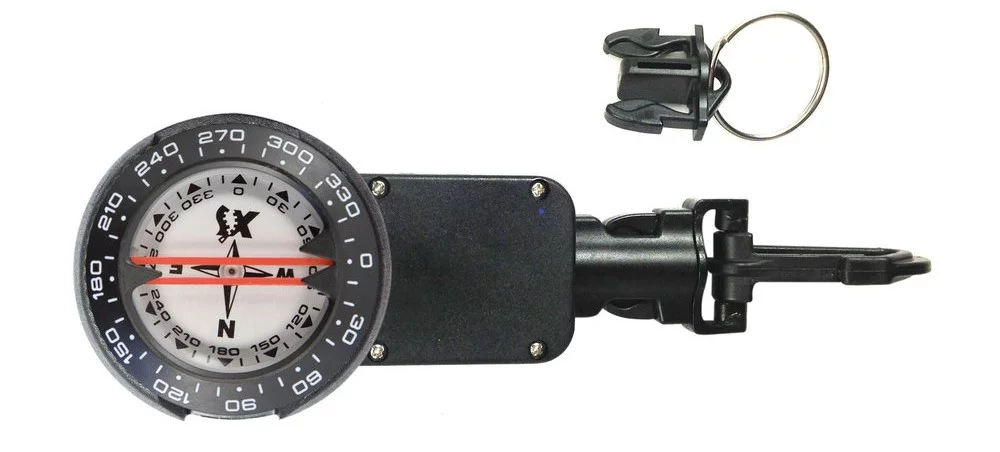
While the latest compass from XS Scuba, the SuperTilt, offers varying means of mounting, it is most notable for its retractable feature. It can be used as a wrist watch, console, or most effectively, clipped to the BCD and retracted. It attaches through a secure, plastic snap hook and can pull up to approximately 25 inches. As many of the other compasses listed, it too provides side viewing for easy reading of your bearing. The XS Scuba SuperTilt features ten degree increments and is super responsive. As most of the compasses on his list as well, the SuperTilt is very simplistic and easy to use. This is very important to me,as I previously stated, because most scenarios I use a compass in while diving are teaching navigation.
What really stands out to me with the XS Scuba SuperTilt is its namesake feature: it has a high tilt angle for easy reading while diving. This is super convenient because when trying to read a compass while floating neutrally buoyant, it can be a bit difficult to get it totally level for a perfect reading. Unfortunately, it is also priced quite high around $80. Money certainly buys more features and quality when it comes to dive equipment. Of course the other major reason to consider this dive computer is the BCD mount and retractable clip which offers a very convenient set up if a diver does not want the mess of more wrist mounts or hoses. This would be a major determining factor for me as I sometimes get overwhelmed by the amount of clips, computers, and gadgets I have when fully suited up.
Key Features:
- Retractable 25 Inches
- BCD, Wrist, or Console Mount Options
- Ten Degree Increments
- High Angle Tilt
Pros:
- Best BCD mount option
- Retractable clip for easy access
- Easy and simplified to use
- High angle tilt feature makes for accurate readings
- High precision readings
Cons:
- Also a bit high of price point
- A bit bulky in size
- Retractable feature has been known to affect compass accuracy
Frequently Asked Questions
Does it really matter what kind of mounting I choose for my compass?
Yes. But there’s no wrong choices! The type of mount matters because a compass is an emergency navigation tool when it comes down to it. We learn to use them when diving so we can gain the skills required to navigate back to familiar waters if we get lost. Hopefully a diver never gets in this situation, but should they find themselves there, the compass needs to be easy and convenient to access. Do you use a wrist watch style dive computer? Then I would be inclined to recommend a wrist mount as you may be used to checking your dive computer on your wrist. The same assumption goes for a hose or SPG mount. I would be inclined to recommend a BCD mount if you already use a lot of gadgets and gizmos and need to keep your equipment set organized underwater.
Is it necessary to own a compass if I don’t intend to use it for dive training purposes?
Once again, yes! Unfortunately I’ve begun to see divers disregard the dive compass as an essential component of a scuba equipment set, but I’m here to end that. Not only do they allow us to effectively navigate existing dive sites and map new ones, they are an emergency tool a diver could use for search and recovery techniques, lost diver searches, or even should you get lost yourself. A dive compass is a must-have, and at a relatively low cost compared to other dive equipment, they don’t come as much of a burden.
Why do you mention cost so much when talking about compasses?
In my reviews, cost was a major aspect in choosing which compasses to feature and my recommendations on purchasing them. The reason is that diving can be a very expensive hobby, especially when purchasing your own equipment set. Some pieces of equipment have standard features and don’t really require us to dish out too much money. Sure, if you have cash to spend and want to invest in a higher priced compass, more power to you. However, I think there is no shame in spending around $30 or below and saving your money for other important purchases like a computer or BCD.
How often will I realistically use a compass while diving?
This is totally up to the diver. Some never use a compass beyond training during courses. Some people use a compass everytime they dive. I probably use them the most for teaching purposes, but I also find them incredibly useful in navigating dive sites I am unfamiliar with and have even used them in my own “lost diver” situation when a buddy and I lost track of where we were.
If I choose to get a computer with an integrated compass, what would you recommend?
I recommend the Shearwater Perdix. It is the current computer I am using and it is my favorite piece of dive gear I own. Although the navigation does not provide too many features, I find the compass super convenient and easy to use. Keep in mind, this is not a computer for everyone. It demands a pretty high price and is not for beginners. However, the possibilities are endless with this computer!